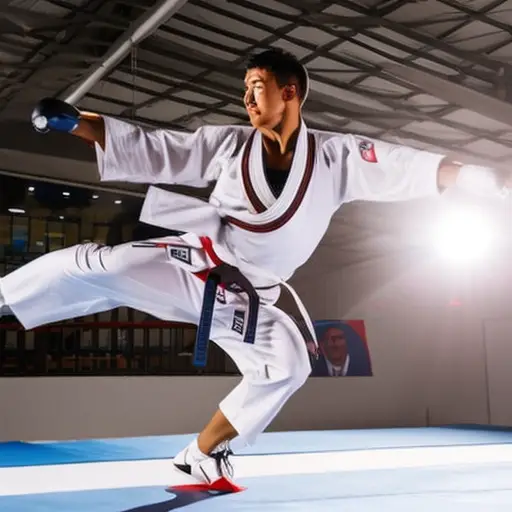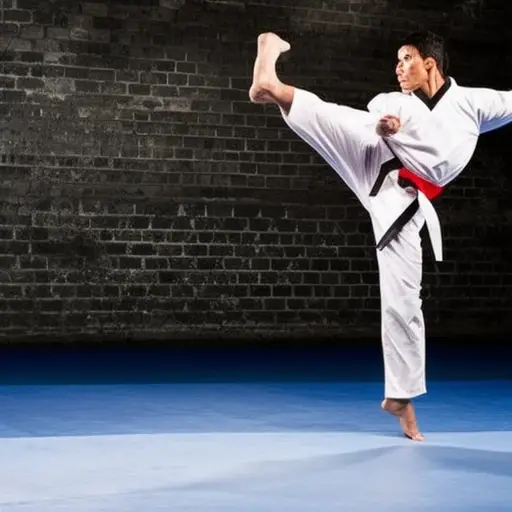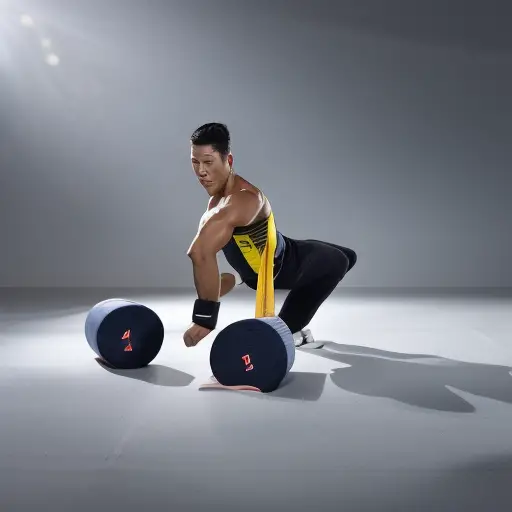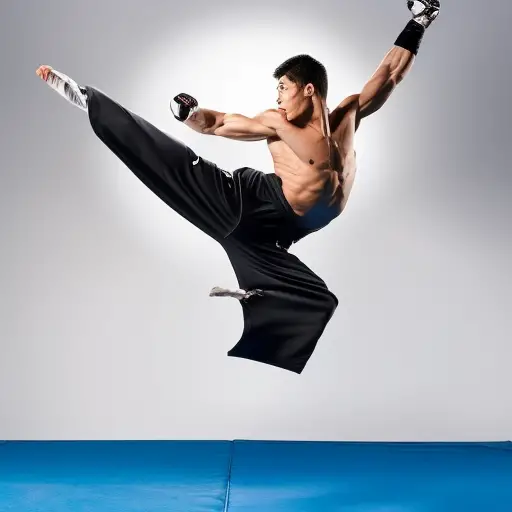Training for Taekwondo Tournaments

Are you ready to kick your taekwondo training up a notch?
In this article, we delve into the essential components of training for taekwondo tournaments.
From physical conditioning and technique development to sparring strategies and mental focus, we cover it all.
Discover the secrets to success in the ring as we explore the importance of flexibility, strength, and proper nutrition.
Get ready to elevate your game and reach new heights in the world of taekwondo tournaments.
Physical Conditioning
To optimize performance in taekwondo tournaments, athletes must engage in rigorous physical conditioning to enhance their strength, endurance, and flexibility. Cardiovascular endurance is crucial in taekwondo as it enables athletes to sustain high-intensity movements over a prolonged period. To improve cardiovascular endurance, athletes should incorporate activities such as running, cycling, or swimming into their training regimen. These exercises not only increase heart rate and lung capacity but also improve overall stamina.
In addition to cardiovascular endurance, speed training plays a vital role in taekwondo. Quick and explosive movements are essential in executing various techniques effectively. Athletes can enhance their speed by incorporating exercises such as sprints, agility ladder drills, and plyometric exercises into their training routine. These activities not only improve muscle strength but also enhance the body’s ability to generate power rapidly.
Technique Development
Through consistent practice and refinement, taekwondo athletes can cultivate their technique, enabling them to execute precise and powerful movements in tournament settings. Technique refinement is a crucial aspect of taekwondo training as it allows athletes to improve their skill progression and ultimately perform at their best during competitions. Here are three key ways in which taekwondo practitioners can develop their technique:
-
Repetition and precision: By consistently practicing basic techniques such as kicks, punches, and blocks, athletes can refine their movements and develop muscle memory. Through repetition, they can enhance their precision, ensuring that their techniques are executed with accuracy and efficiency.
-
Focus on fundamentals: Mastering the fundamental techniques is essential for any taekwondo athlete. By dedicating time and effort to perfecting the basics, athletes can build a strong foundation that will support their overall skill progression. This includes developing proper stances, balance, and body positioning.
-
Incorporating advanced techniques: Once athletes have mastered the basics, they can begin to incorporate more advanced techniques into their training. This includes complex kicks, combination movements, and defensive strategies. By continuously challenging themselves with new techniques, athletes can further refine their skills and expand their repertoire.
Sparring Strategies
With a solid foundation in technique development, taekwondo athletes can employ effective sparring strategies to maximize their performance in tournaments. Sparring techniques play a crucial role in taekwondo tournaments as they allow athletes to showcase their skills and score points against their opponents.
One of the key sparring techniques in taekwondo is the use of kicks, which can be executed with precision and speed to catch opponents off guard. Athletes should focus on developing a diverse range of kicks, including front kicks, side kicks, roundhouse kicks, and back kicks, to keep their opponents guessing and create scoring opportunities.
In addition to mastering sparring techniques, athletes must also develop scoring strategies to outperform their opponents. These strategies involve analyzing the opponent’s weaknesses and capitalizing on them. Athletes can use feints and fakes to deceive their opponents and create openings for scoring. Timing is also crucial in taekwondo sparring, as athletes need to anticipate and react quickly to their opponent’s movements. By studying their opponents’ patterns and tendencies, athletes can develop effective counter-attacks and scoring opportunities.
Furthermore, athletes should focus on maintaining a strong defense while sparring. This involves blocking and evading the opponent’s attacks to minimize the risk of being scored against. Effective footwork and body positioning are essential in taekwondo sparring, allowing athletes to maintain a strong defensive stance while also creating opportunities for offensive maneuvers.
Flexibility and Agility Training
During the training for taekwondo tournaments, athletes should prioritize incorporating flexibility and agility exercises into their routine. These exercises are essential for enhancing performance, preventing injuries, and improving overall martial arts skills.
Here are three key flexibility exercises and agility drills that taekwondo athletes should include in their training:
-
Static Stretching: Static stretching involves holding a stretch for a prolonged period, targeting specific muscles and joints. This helps improve flexibility and range of motion, which is crucial for executing high kicks and quick movements in taekwondo.
-
Dynamic Stretching: Dynamic stretching involves moving parts of your body through a full range of motion. It helps warm up the muscles and increases blood flow, preparing them for intense physical activity. Dynamic stretches include leg swings, arm circles, and high knees.
-
Agility Ladder Drills: Agility ladder drills are excellent for improving footwork, coordination, and quickness. Athletes perform various movements, such as lateral shuffles, high knees, and quick stepovers, through the ladder’s rungs. These drills enhance agility, reaction time, and body control, key elements in taekwondo sparring.
Incorporating these flexibility exercises and agility drills into training sessions will help taekwondo athletes excel in tournaments by increasing their overall performance and reducing the risk of injuries. Regular practice and consistency are vital to achieving optimal results.
Strength and Power Training
Strength and power training are essential components of a taekwondo athlete’s preparation for tournaments.
Plyometrics, which involve explosive movements, help develop the fast-twitch muscle fibers required for powerful kicks and punches.
Additionally, weightlifting exercises, such as squats and deadlifts, build overall muscle strength, enabling athletes to generate more force in their techniques.
Plyometrics for Explosive Power
To maximize explosive power in taekwondo athletes, incorporating plyometric exercises into their training regimen is essential. Plyometric training focuses on quick, powerful movements that improve muscle strength and explosiveness. Here are three key benefits of plyometric exercises for taekwondo athletes:
-
Increased Power: Plyometric exercises such as box jumps, squat jumps, and tuck jumps help develop fast twitch muscle fibers, resulting in increased power and explosiveness in kicks and strikes.
-
Enhanced Agility: Plyometric training improves coordination, balance, and agility, allowing athletes to rapidly change direction and execute techniques with precision.
-
Injury Prevention: Plyometric exercises strengthen the muscles, tendons, and ligaments, reducing the risk of injury during high-intensity movements.
By incorporating plyometric exercises into their training routine, taekwondo athletes can enhance their explosive power, agility, and overall performance.
Now let’s transition into the subsequent section about ‘weightlifting for muscle strength’.
Weightlifting for Muscle Strength
Weightlifting exercises, such as deadlifts and bench presses, are essential for taekwondo athletes looking to build muscle strength and power. These exercises focus on compound movements that engage multiple muscle groups simultaneously, allowing for maximum muscle recruitment and growth.
Deadlifts, for example, target the muscles of the legs, back, and core, while bench presses primarily work the chest, shoulders, and triceps. By incorporating weightlifting techniques into their training regimen, taekwondo athletes can improve their overall muscle building capacity, leading to increased strength and power in their kicks and strikes.
To optimize muscle building, it is important for taekwondo athletes to focus on proper form and technique when performing weightlifting exercises. This includes maintaining a neutral spine, engaging the core muscles, and using a full range of motion.
It is also crucial to gradually increase the weight lifted over time to continue challenging the muscles and stimulating growth. Additionally, incorporating variations of weightlifting exercises, such as incline bench presses or sumo deadlifts, can target specific muscle groups and provide a well-rounded strength training program.
Mental Focus and Visualization
Mental focus and visualization play a crucial role in the training and preparation for taekwondo tournaments.
Visualization allows athletes to mentally rehearse their techniques and strategies, enhancing muscle memory and improving overall performance.
Techniques for mental focus, such as deep breathing and positive self-talk, help athletes stay focused and composed in high-pressure situations.
Importance of Visualization
Enhancing performance in taekwondo tournaments requires athletes to harness the power of mental focus and employ visualization techniques. Visualization plays a crucial role in mental preparation as it allows athletes to mentally rehearse their moves and strategies.
Here are three reasons why visualization is important for taekwondo athletes:
-
The power of imagination: Visualization taps into the power of imagination, allowing athletes to create vivid mental images of their ideal performance. By visualizing success, athletes can program their minds to believe in their abilities and increase their confidence.
-
Mental rehearsal: Visualization serves as a form of mental rehearsal, enabling athletes to practice their techniques and routines in their minds. This helps improve muscle memory and enhances the execution of movements during actual competition.
-
Focus and concentration: Visualization helps athletes develop focus and concentration by training their minds to block out distractions and stay fully present in the moment. By visualizing themselves performing with precision and clarity, athletes can enhance their ability to stay focused under pressure.
Techniques for Mental Focus
Developing a strong mental focus is essential for taekwondo athletes to optimize their performance and achieve success in tournaments. Enhancing concentration and employing mindfulness techniques can greatly contribute to mental focus. Here are some techniques that taekwondo athletes can use to improve their mental focus:
| Technique | Description |
|---|---|
| Deep breathing | Deep breathing exercises help to calm the mind and increase focus. By focusing on the breath, athletes can enhance their concentration and reduce distractions. |
| Visualization | Visualization involves mentally rehearsing techniques, strategies, and successful performances. This helps athletes create a clear mental image of their desired outcomes, enhancing their focus and confidence. |
| Meditation | Practicing meditation can improve mental discipline and boost concentration. Meditation techniques, such as mindfulness meditation, promote a state of present-moment awareness, allowing athletes to stay focused on the task at hand. |
Enhancing Tournament Performance
To maximize tournament performance, taekwondo athletes can employ specific techniques that promote optimal mental focus and incorporate visualization strategies. These methods not only enhance concentration but also improve overall performance during competitions.
Here are three essential techniques that can help taekwondo athletes enhance their tournament performance:
-
Visualization Techniques: Athletes can use visualization to mentally rehearse their moves, routines, and strategies. By vividly imagining themselves executing flawless techniques, athletes can enhance muscle memory and build confidence.
-
Hydration Importance: Staying hydrated is crucial for maintaining peak performance. Dehydration can lead to fatigue, decreased focus, and impaired decision-making abilities. Taekwondo athletes should ensure they drink enough water before, during, and after tournaments to stay properly hydrated.
-
Mental Focus Exercises: Taekwondo athletes can practice various mental focus exercises such as mindfulness meditation, deep breathing, and positive affirmations. These exercises help athletes calm their minds, increase concentration, and reduce anxiety before and during tournaments.
Nutrition and Hydration
A balanced diet is essential for optimal performance and recovery in taekwondo tournaments. Proper nutrition provides the necessary fuel to sustain intense training sessions and ensures that the body is adequately prepared for competition. Staying hydrated is equally important, as dehydration can negatively impact performance and increase the risk of injury.
To maintain proper nutrition, taekwondo athletes should focus on consuming a variety of nutrient-dense foods. This includes lean proteins such as chicken, fish, and tofu, which help repair and build muscle tissue. Complex carbohydrates like whole grains, fruits, and vegetables provide sustained energy throughout training and competition. Healthy fats from sources like avocados, nuts, and olive oil aid in nutrient absorption and support joint health.
In addition to a balanced diet, staying hydrated is crucial for taekwondo athletes. Dehydration can lead to muscle cramps, fatigue, and decreased cognitive function. It is recommended to drink water before, during, and after training sessions and tournaments to replenish fluids lost through sweat. Electrolyte-rich sports drinks can also be beneficial for prolonged or intense exercise to replace electrolytes lost through sweating.
Recovery and Injury Prevention
Efficient recovery and injury prevention strategies are essential for taekwondo athletes to maintain their physical well-being and optimize their performance in tournaments. The rigorous training and intense physical demands of taekwondo can often lead to muscle soreness, fatigue, and the risk of injury. To counteract these challenges, athletes must focus on proper recovery techniques and injury prevention methods.
Here are three important strategies that taekwondo athletes should incorporate into their training regimen:
-
Rehabilitation Techniques: In case of an injury, proper rehabilitation techniques are crucial for a safe and effective recovery. This may include physical therapy, targeted exercises, and other modalities like cold and heat therapy. Rehabilitation helps athletes regain strength, flexibility, and range of motion, thereby reducing the risk of reinjury.
-
Stretching Exercises: Stretching plays a vital role in injury prevention for taekwondo athletes. Dynamic stretching before training helps warm up the muscles and increase their flexibility, reducing the risk of strains and sprains. Static stretching after training helps to cool down the body and prevent muscle soreness.
-
Rest and Recovery: Adequate rest and recovery are essential for the body to repair and rebuild itself. This includes getting enough sleep, taking regular rest days, and incorporating active recovery techniques like foam rolling and massage.
Frequently Asked Questions
How Do I Choose the Right Taekwondo Tournament to Participate In?
When choosing tournaments to participate in, it is essential to consider factors such as the level of competition, tournament format, rules, and location. Preparing for tournaments also involves physical training, mental preparation, and strategic planning.
What Equipment Do I Need for a Taekwondo Tournament?
To compete in a taekwondo tournament, participants require specific equipment and gear. This includes items such as a dobok (uniform), protective gear (headgear, chest protector, shin guards), hand and foot gear, and a mouthguard.
How Do I Manage Pre-Competition Nerves and Anxiety?
Managing performance anxiety and pre-competition nerves is crucial for athletes. Incorporating mental preparation techniques such as visualization, deep breathing exercises, positive self-talk, and maintaining a routine can help alleviate anxiety and enhance performance in taekwondo tournaments.
Are There Any Specific Warm-Up Exercises Recommended Before a Taekwondo Tournament?
Dynamic stretches and breathing exercises are recommended as part of a warm-up routine before participating in a taekwondo tournament. These exercises help increase flexibility, improve blood flow, and prepare the body for the physical demands of the competition.
How Do I Deal With Setbacks or Disappointments During a Tournament?
Dealing with setbacks and managing disappointment during a tournament requires mental resilience and a positive mindset. It is important to acknowledge and process the emotions, learn from the experience, and focus on future opportunities for growth and improvement.
Conclusion
In conclusion, training for taekwondo tournaments requires a holistic approach that encompasses:
- Physical conditioning
- Technique development
- Sparring strategies
- Flexibility and agility training
- Strength and power training
- Mental focus and visualization
- Nutrition and hydration
- Recovery and injury prevention
As the saying goes, ‘Success is not the result of spontaneous combustion. You must set yourself on fire.’ This adage emphasizes the importance of dedication, hard work, and perseverance in achieving success in taekwondo tournaments.





